
The fancy rat is the domesticated form of Rattus norvegicus, the brown rat, and the most common species of rat kept as a pet. The name fancy rat derives from the idea of animal fancy or the phrase "to fancy". Wild-caught specimens that become docile and are bred for many generations still fall under the fancy type.
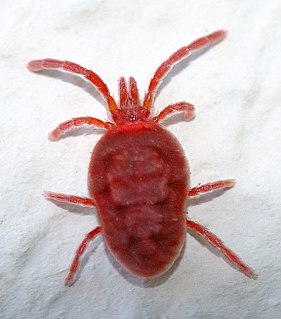
Mites are small arachnids.

The house mouse is a small mammal of the order Rodentia, characteristically having a pointed snout, large rounded ears, and a long and hairy tail. It is one of the most abundant species of the genus Mus. Although a wild animal, the house mouse has benefited significantly from associating with human habitation to the point that truly wild populations are significantly less common than the semi-tame populations near human activity.

The laboratory mouse or lab mouse is a small mammal of the order Rodentia which is bred and used for scientific research. Laboratory mice are usually of the species Mus musculus. They are the most commonly used mammalian research model and are used for research in genetics, psychology, medicine and other scientific disciplines. Mice belong to the Euarchontoglires clade, which includes humans. This close relationship, the associated high homology with humans, their ease of maintenance and handling, and their high reproduction rate, make mice particularly suitable models for human-oriented research. The laboratory mouse genome has been sequenced and many mouse genes have human homologues.

A fancy mouse is a domesticated form of the house mouse, one of many mouse species, usually kept as a type of pocket pet. Fancy mice have also been specially bred for exhibiting, with shows being held internationally. A pet mouse is inexpensive compared to larger pets, and even many other pet rodents, but mice are comparatively short-lived: typically only 18 to 30 months.
Notiomys edwardsii, also known as Edward's long-clawed akodont, Milne-Edwards' long-clawed mouse, or Edwards's long-clawed mouse, is a rodent in the tribe Abrotrichini from southern Argentina. It is the only species in the genus Notiomys, although species of Chelemys and Geoxus were formerly included in that genus.

Peromyscus maniculatus is a rodent native to North America. It is most commonly called the deer mouse, although that name is common to most species of Peromyscus, and thus is often called the North American deermouse and is fairly widespread across the continent, with the major exception being the southeast United States and the far north.
The link rat is a species of rodent in the family Muridae. It is also known by the common name Congo forest mouse. It is native to central Africa.

Demodex folliculorum is a microscopic mite that can only survive on the skin of humans. Most people have D. folliculorum on their skin. Usually, the mites do not cause any harm, and are therefore considered an example of commensalism rather than parasitism. If D. folliculorum does cause disease, this is known as demodicosis.
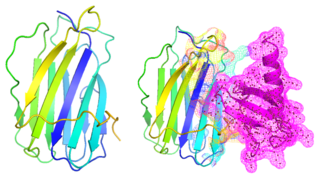
Ectromelia virus (ECTV) is a virus of the family Poxviridae and the genus Orthopoxvirus that causes mousepox, a disease of mice. It has only been seen in mouse colonies kept for research purposes but believed that wild populations of mice and other rodents in Europe are naturally infected with ECTV. Mousepox causes skin lesions, a purulent rash on the body of mice, and generalized disease, which can be fatal. It is the only poxvirus to cause disease naturally in mice.

Chronic progressive lymphedema (CPL) is a disease of some breeds of draft horse, whereby the lower legs becomes progressively more swollen. There is no cure; the aim of treatment is to manage the signs and slow progression of the disease. The cause of CPL is not known, although it is suspected that a genetic disorder of elastin metabolism prevents the lymphatic vessels from functioning properly, leading to edema of the lower limbs. CPL resembles the human disease elephantiasis verrucosa nostra.

Dermanyssus gallinae is a haematophagous ectoparasite of poultry. It has been implicated as a vector of several major pathogenic diseases. Despite its common names, it has a wide range of hosts including several species of wild birds and mammals, including humans. In both size and appearance, it resembles the northern fowl mite, Ornithonyssus sylviarum.
The Western Saharan spiny mouse or Aïr spiny mouse is a species of small, insectivorous rodent in the family Muridae found arid regions of western Africa.
The montane hylomyscus or montane wood mouse is a species of rodent in the family Muridae. A long-coated species with brownish-grey upper parts and whitish-grey underparts, it occurs in the uplands of tropical Central Africa where its natural habitat is tropical moist montane forests.

Rodents are mammals of the order Rodentia, which are characterized by a single pair of continuously growing incisors in each of the upper and lower jaws. Rodents are the most diverse order of mammals with at least 2552 currently recognized species of living rodents, representing about 39.3% of all mammals. Rodents are native to all major land masses except for New Zealand, Antarctica, and several oceanic islands, though they have subsequently been introduced to most of these land masses by human activity.

Trombicula autumnalis, known as the harvest mite or autumn chigger, is a species of mite of the family Trombiculidae. Their larvae live parasitically; they infect all domestic mammals, humans, and some ground-nesting birds.
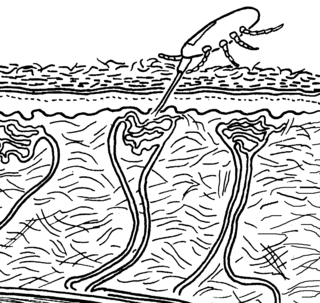
Gamasoidosis or dermanyssosis is a frequently unrecognized ectoparasitosis and source of growing concern in human medicine, occurring after contact with avian mites which infest canaries, sparrows, starlings, pigeons and poultry and caused by two genera of mites, Ornithonyssus and Dermanyssus. Avian mite species implicated include the red mite, tropical fowl mite and northern fowl mite . Mite dermatitis is also associated with rodents infested with the tropical rat mite, spiny rat mite and house-mouse mite, where the condition is known as rodent mite dermatitis. Urban gamasoidosis is associated with window-sills, ventilation and air-conditioning intakes, rooves and eaves, which serve as shelters for nesting birds. Humans bitten by these mites experience a non-specific dermatitis with intense itching.
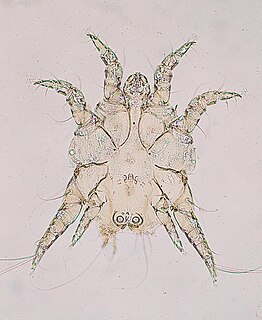
Psoroptidae is a family of parasitic mites, which are 1–2 mm (0.039–0.079 in) long and live on the surface of the skin, rather than burrowing into it. These mites affect various species, including cats, dogs, rabbits, cattle, sheep, and horses, causing skin inflammation, scabs, crusting, and hair loss.
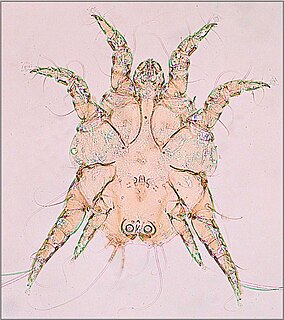
Mites that infest and parasitize domestic animals cause disease and loss of production. Mites are small invertebrates, most of which are free living but some are parasitic. Mites are similar to ticks and both comprise the order Acari in the phylum Arthropoda. Mites are highly varied and their classification is complex; a simple grouping is used in this introductory article. Vernacular terms to describe diseases caused by mites include scab, mange, and scabies. Mites and ticks have substantially different biology from, and are classed separately from, insects. Mites of domestic animals cause important types of skin disease, and some mites infest other organs. Diagnosis of mite infestations can be difficult because of the small size of most mites, but understanding how mites are adapted to feed within the structure of the skin is useful.
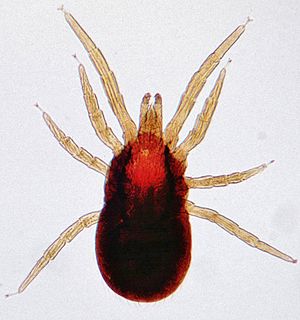
Mites are small crawling animals related to ticks and spiders. Most mites are free-living and harmless. Other mites are parasitic, and those that infest livestock animals cause many diseases that are widespread, reduce production and profit for farmers, and are expensive to control.
















